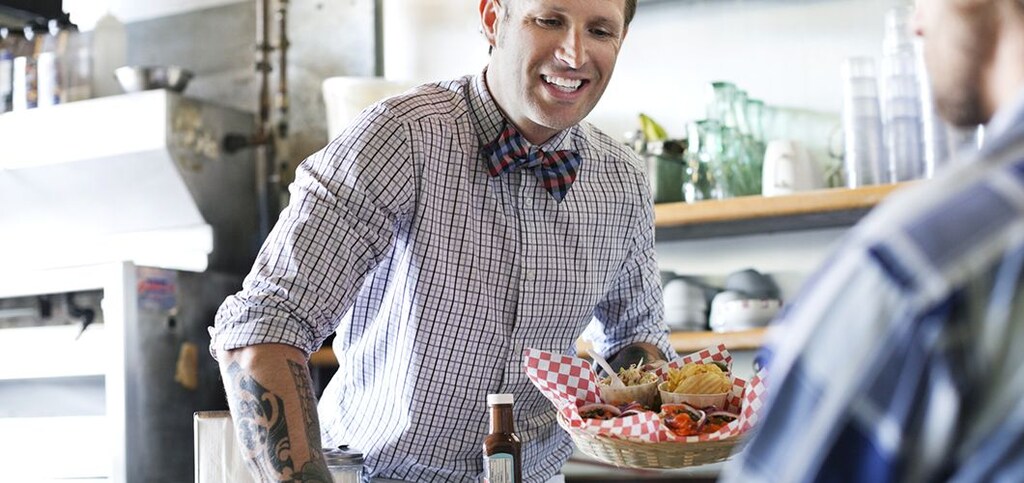After a dyspeptic 2014 that saw above-average increases in food costs—led by a nearly 13 percent increase in the price of meats—many restaurant businesses are hoping for moderated food costs in 2015, along with an improving economy that could permit them to pass some of their rising costs on to consumers.
Food and beverage costs typically swallow one-third of the average restaurant business’s revenue, so when a staple like beef rises more than 18 percent, as it did from November 2013 to November 2014, according to U.S. Department of Agriculture (USDA) figures, many eateries feel pressed by food costs like never before.
“There’s been nothing this drastic in the period of time we’ve been in business,” says Frank Lara, director of operations for Chompie’s, a New York-style deli and bakery chain in Phoenix that opened its doors in 1979. Some of the meats that Chompie’s piles on its mountainous sandwiches increased by as much as $3 per pound in a single month as the year ended, Lara adds.
The Food Forecast
For 2015, the USDA forecasts a 2 to 3 percent increase in overall food prices, in line with historical norms, which looks a lot like relief for worried restaurant owners. The USDA is expecting the rise in meat costs to average out to somewhere between 3.5 and 4.5 percent.
Moderated food cost increases could get a tailwind from an expected increase in restaurant sales. In 2014, the industry posted record-high revenues of $683 billion, according to Hudson Riehle, senior vice president of research for the Washington, DC-based National Restaurant Association (NRA) trade group. The nearly $50 billion monthly tab U.S. diners paid in December was the largest on record.
One way restaurant operators are likely to respond to this improving environment is to raise prices. Average menu prices increased at a 2.3 percent annual rate through November 2014, Riehle points out. That’s significantly above the 2.1 percent average increase of 2013, but it will probably take more than that to help restaurants, which average pretax profits of 3 to 5 percent, to make up for the cost tsunami of 2014.
Still, Riehle expects menu price hikes to be moderate. “With over 1 million restaurants across the country, competition remains intense,” he says. “So operators are judicious about when they implement menu prices increase.”
Taking Steps for the Future
Meanwhile, it's food prices rather than competition that remain the challenge of the day in the restaurant industry, with 31 percent of the restaurant businesses the NRA recently surveyed citing food costs as their biggest current challenge. That was nearly three times the number who claimed the same thing a year ago.
Fortunately, restaurants have more options for dealing with the challenge than raising their own prices or taking losses. While Chompie’s increased prices by about 5 percent in 2014, Lara points out they’ve also focused on operational efficiency to cut costs, including reducing their waste-caused shrinkage when meats are cooked.
Portion control is another focus, although Lara claims his restaurants are reluctant to reduce the amount of meat customers expected them to pile on their jaw-stretching sandwiches. So they’ve also ramped up marketing to draw customers for breakfast, when menu items incorporate lower food costs. Finally, they’ve developed new menu items and promoted dishes, such as fish tacos and smoked fish, that are built around seafood, which has seen much lower price hikes than beef and pork.
Looking forward, menu-makers have room to design inflation-free dishes with ingredients such as grains and cereals, bakery products and fresh vegetables, all of which saw much smaller price increases, if any, during 2014. Some foods, such as processed fruits and vegetables and sugar and sweets, even saw some small price declines, according to the USDA.
Another plus: So far, 2015 seems unlikely to usher in the price increases the industry saw in 2014, when pork prices rose 9.9 percent and eggs were up 6.2 percent. “Obviously, in 2015, we wouldn’t expect wholesale food price inflation to be on the level it was in 2014,” Riehle says. “Then again, there isn't much reason to think there's going to be a turnaround situation.”
But Riehle could be wrong: Forecasts are calling for declining prices for basic agricultural products such as corn and soybeans, which provide the feedstock for beef and pork, and that could lower meat prices. On the other hand, livestock herds have been declining in recent years, which created a scarcity that drove last year’s run-up in prices, and it takes time for ranchers to rebuild their herds. Lara says he doesn’t anticipate beef prices to stabilize for another few years.
Taking into account all the expected changes, industry experts are predicting it won’t get worse for the nation’s restaurants, which can expect some breathing room and a chance to leverage new efficiencies and more profitable menu items into what could be a banner year.
“These are better times,” Riehle says. “2015 will be a better environment than 2014, and 2016 will be a better environment than 2015. It's a gradual, long-term improvement going forward.”
Read more articles on small-business news.
Photo: Getty Images




